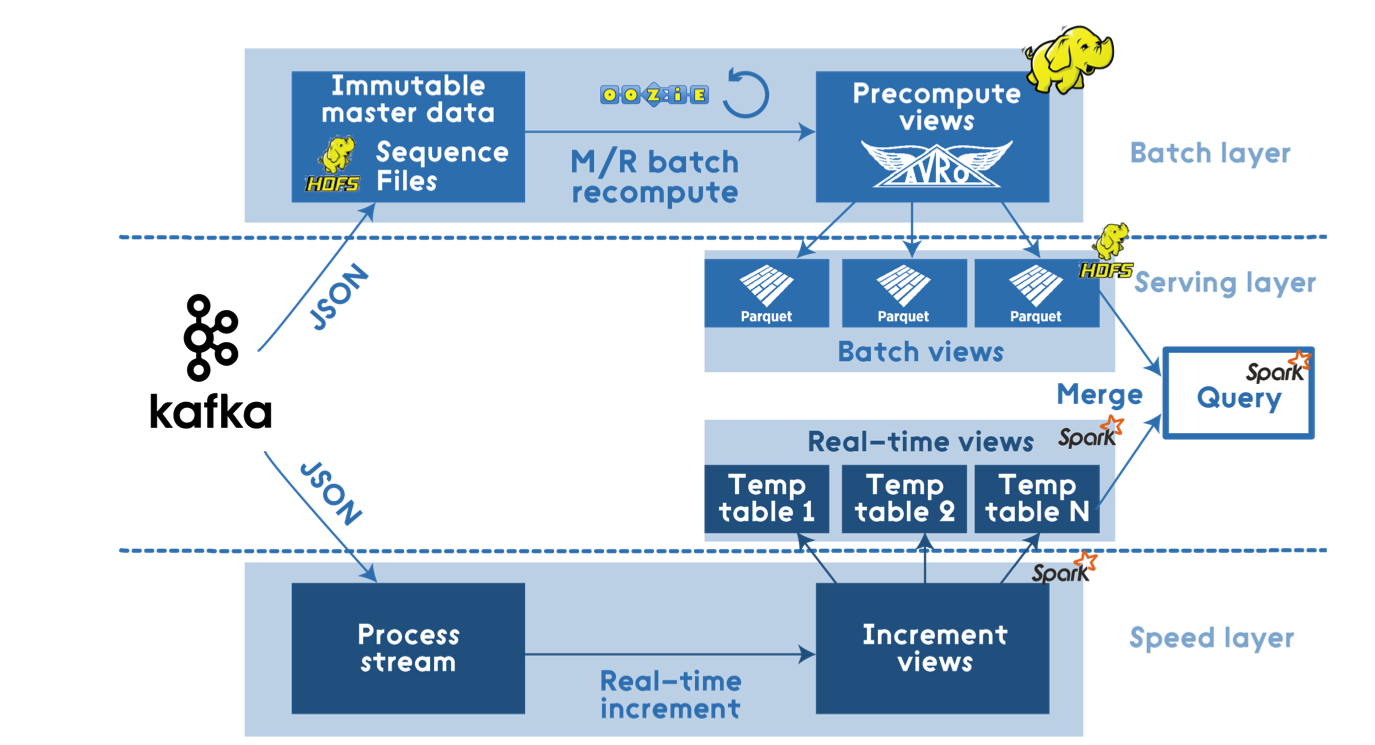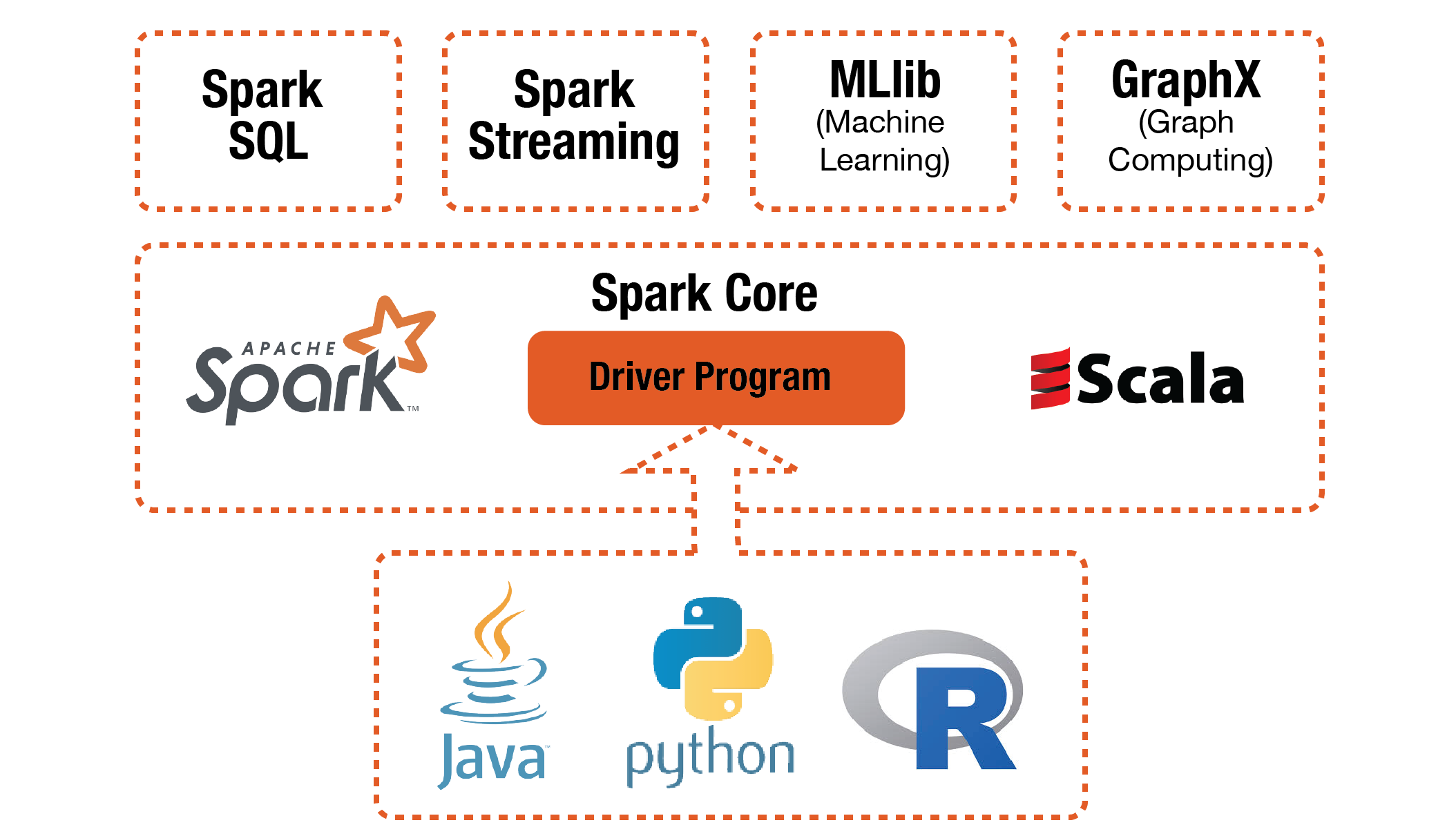Getting started with Spark
In big picture perspective, Apache Spark can be considered as an all in one package Lambda Architecture solution.
Batch layer:
- Spark Core that includes high-level API and an optimized engine that supports general execution graphs.
Serving Layer:
- Spark SQL for SQL and structured data processing.
Speed Layer:
- Spark Streaming that enables scalable, high-throughput, fault-tolerant stream processing of live data streams.
Batch processing using Spark might be quite expensive and will not fit for all scenarios and data volumes, but the easy integration with the Hadoop Ecosystem allow it to generalize into more use cases.
Apache Spark was first developed in 2009 by AMPLab at UC Berkeley as a research project. It started with the creation of Mesos (a cluster management tool) and wanting a system to be built on top of it by some of the original developers lead by Ion Stoica (UC Berkley Professor, and CEO of DataBricks). Requirements for Machine Learning on top of Hadoop was being introduced by the University, and many near-by tech companies, including Stoica’s company Conviva, had required interactive fast querying abilities. It was first released at May 30th, 2014 (only 3 years ago) and later donated to the Apache Software Foundation which has maintained it ever since.
It is an open-source, fault-tolerant batch-computing framework like Hadoop. It provides us several APIs to manipulate a special kind of datasets called RDD (Resilient Distributed Dataset), a distributed memory abstraction that lets programmers perform in-memory computations on large clusters in a fault-tolerant manner. RDDs were motivated by the needs for iterative algorithms and interactive data mining tools. In both cases, keeping data in memory can improve performance by an order of magnitude.
Spark Core is the foundational component:
- Spark Core
Spark Core provides distributed task dispatching, scheduling, basic I/O etc. All these functionalities are exposed through an application programming interface (for Java, Python, Scala, and R) called driver program. We tell the driver program what we want to do by passing a function. And it calls the Spark Core to do the low-level jobs for us.
Built on top of the Spark Core, Spark provide 4 higher-level libraries for special purpose jobs:
- Spark SQL
Spark SQL provides a data abstraction called DataFrames that support both structured or semi-structured data.
- Spark Streaming
Spark Streaming is used for steaming analysis because of the speed of computation.
- MLlib
MLlib is used for machine learning jobs. Specifically, it includes following machine learning techniques and models: - Statistics like correlations, stratified sampling, hypothesis testing, random data generation. - Classificationa and Regression like SVM, logistic regression, linear regression, decisoon tree, naive Bayes. - Collaborativbe Filtering like alternating least squares - Cluster Analysis like kmeans and Latent Dirichletian Allocation - Dimension Reduction like SVD and PCA - Feature Extraction and Transformation - Optimization like SGD, L-BFGS.
- GraphX
GraphX is used for graph processing like PageRank and so on.
All we do with data can be generalized as applying some operations on some dataset. Spark is designed in this way too.
The special kind of datasets in Spark--Resilient Distributed Datasets(RDDs)--form the foundation of Spark. Basically, an RDD is a collection of tuples. What is special about RDD is that you can keep it in memories of machines by using persist() or cache() method. On addition to that, you can specify the storage level to control how it is saved.
By default, Spark saves the RDD as de-serialized Java objects in memory. And if the RDD is too big, the part that doesn't fit will not be cached and will be recomputed on the fly every time they are needed. (For the full set of storage levels and their details, check here.)
This is the key difference between Spark and Hadoop. Because as we know, Hadoop dose not save any output in memory, even the intermediate key/value pairs coming out of map function are saved to local disk and being retrieved by reducer. The serialization/deserialization during I/O make the process very inefficient if we need to use the same dataset from time to time. (Think about tuning models in Machine Learning.) In contrast, the RDDs used in Spark can stay in memory thus allows up to use them iteratively and interactively repeatedly without having to read them from disk.
The operations to manipulate RDD in Spark are high level and flexible. It is high-level because it saves us from disk I/Os and provide a variety of high-level operations like JCascalog and other libraries for Hadoop. It is flexible because lots of the operations work with custom functions implemented for specific purpose by ourselves. In general, the operations are categorized into transformations and actions:
-
Transformations: all the operations take in RDD and return a new RDD are considered transformations. Below are some of them:
Transformation Meaning map(function) use the input function to process each row of RDD and return a new processed RDD filter(function) use the input function to evaluate each row of RDD and remove the rows evaluated false union(otherDataset) return the union of 2 data sets based on identical fields reduceByKey(function, [numTasks]) return a new RDD in which values of same key are aggregated ... ... -
Actions: all the operations take in RDD and return something that is not RDD are considered actions. For example:
Actions Meaning reduce(function) aggregate the elements of RDD using provided function collect() return all the elements in RDD as an array rake(n) return the elements of first n rows in RDD as an array saveAsSequenceFile(path) with the elements of the dataset as a Hadoop SequenceFile in a given path in local filesystem ... ...
For more operations and details, check -> https://spark.apache.org/docs/latest/rdd-programming-guide.html#transformations
Working under this framework, Spark will be able to understand your opearations and optimize them as a pipeline what they called "lineage" and when some slave machines go down, it will fetch the original RDD and apply the lineage to recover the results.
On addition to these basic, one-step type of operations, Spark offers more complex operations in those 4 specific purpose libraries we talked about in last section. And these complex operations are nothing more than a combination of basic operations.
As we said, the main advantage of Spark is the RDD. It's fast for iterative algorithm and interactive developing environment. And it's convenient to use those 4 specific purpose libraries if they suit our needs.
Apache Spark Documentation: (https://spark.apache.org/docs/latest/index.html) Wikipedia: Apache Spark: () Apache Spark GitHub Repository: (https://github.com/apache/spark)
More info: The Apache Spark Project
Group Project for Big Data Programming, Fall 2017
Project master repository: Master Branch

